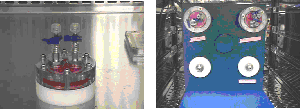Cell Adhesion Study Using Simulated Microgravity
Over the past 10 years, studies in the area of
culturing functional tissue have been addressing what effects simulated
microgravity have on tissue development. When cells are cultured
under conditions of minimal gravity, these cells are able to orient and
interact with one another as observed in vivo. The proposed study
addresses the effect simulated microgravity has on endothelial cell
adhesive strength. Specifically, cell-cell and cell-substrate adhesive
strength will be studied. Histological
and morphological analysis of seeded endothelial cells cultured in
simulated microgravity will be performed.
Protein analysis of adhesion proteins, specifically fibronectin
(cell-substrate) and E-cadherin (cell-cell) will be performed, also.
Two control culturing systems will be utilized.
Conventional tissue culture technique will be used to mimic a no
shear with gravity environment. A
perfusion system will be used to mimic a low shear with gravity
environment. Simulated
microgravity culture technique will be used to mimic a low shear, low
gravity environment.
